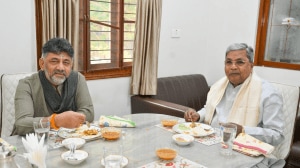India may have to deal with Gyanendra’s China card option
The announcement in the Nepali media last week that a bus service will soon be launched between Kathmandu and Lhasa was not news to South Bl...

The announcement in the Nepali media last week that a bus service will soon be launched between Kathmandu and Lhasa was not news to South Block. For, an agreement on this was signed between Nepal and China last November.
But the public focus on the Lhasa-Kathmandu bus service might be an attempt to highlight Gyanendra’s options on playing the China card to shore up his royal coup d’etat.
Gyanendra has every reason to be happy with the Chinese reaction, which described the coup as an ‘‘internal affair’’ of Nepal even as India condemned it.
Setting up India and China against each other has always been an option for Nepal and is dictated by geography.
No one did it more brazenly than King Mahendra, the father of the present monarch. If Mahendra trampled on Nepal’s first experiment with democracy in 1960, Gyanendra has now wiped out the second experiment, which began in 1990.
Gyanendra might also want to imitate his father in playing the China card against India. But Sino-Indian relations have moved a long way from the early 1960s. They never have been as good as they are today.
At a fundamental level, China might have no desire to replace India, US and Britain as the principal arms suppliers to the Royal Nepalese Army. Nor has China in any way criticised Indian policy towards Nepal until now.
Unlike in the previous decades, China now has an entirely different set of tools to expand its influence in Nepal. These are economic and relate to trade and transport infrastructure.
Gyanendra’s need for Chinese support and Beijing’s desire for Tibet’s economic integration with the southern side of the Himalayas opens up the space for a range of new agreements between Nepal and its northern neighbour.
These include the construction of additional highways linking Nepal and China. Beijing is already building a second road link between Kathmandu and Tibet through Rasuwagadhi and Kerung pass. The present road between Kathmandu and Lhasa, through the Kodari pass, was based on an agreement in the early 1960s. The new road will shorten Nepal’s access to Mount Kailash and Lake Manasarovar.
Beijing also wants to start construction of other roads linking Tibet with eastern and western parts of Nepal. These include the development of the Koshi-Kimathanka corridor in the east and the Jomsom-Lumanthang link in the west.
China hopes that some of these new transport corridors can be extended further south to link up with India’s Gangetic plain. China hopes to connect Tibet and Nepal through optic fibre links and energy pipelines.
There is also some talk about bringing the rail line between mainland China and Tibet closer to the Nepal border. Nepal has been pressing China to sign a free trade agreement similar to the one it has with India. As a growing number of Chinese tourists arrive in Nepal, Beijing is pressing for equal treatment with visitors from India.
In short, Gyanendra has many options in the coming months to demonstrate deepening economic partnership with China. New Delhi, which objected to road links between Nepal and Tibet in the 1960s, will find it hard to do so now. India itself has been seeking transit facilities through Nepal to China.
In maintaining the diplomatic pressure on King Gyanendra, India has succeeded in bringing the US, EU and Britain to similar positions. China, however, could breach a big hole in this international coalition.
To prevent a crack-up of international pressure against Gyanendra, India might have to find ways to deal with Beijing on questions relating to the stability of Nepal.
Given the current positive state of Sino-Indian relations, a consultation between New Delhi and Beijing on Nepal’s future seems sensible.



- 01
- 02
- 03
- 04
- 05




























